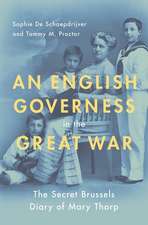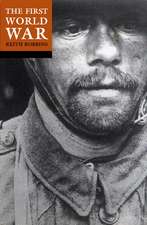Haig and Kitchener in Twentieth-Century Britain: Remembrance, Representation and Appropriation
Autor Stephen Heathornen Limba Engleză Hardback – 3 apr 2013
| Toate formatele și edițiile | Preț | Express |
|---|---|---|
| Paperback (1) | 261.14 lei 6-8 săpt. | |
| Taylor & Francis – 14 oct 2024 | 261.14 lei 6-8 săpt. | |
| Hardback (1) | 1054.71 lei 6-8 săpt. | |
| Taylor & Francis – 3 apr 2013 | 1054.71 lei 6-8 săpt. |
Preț: 1054.71 lei
Preț vechi: 1286.24 lei
-18% Nou
Puncte Express: 1582
Preț estimativ în valută:
201.81€ • 210.71$ • 167.03£
201.81€ • 210.71$ • 167.03£
Carte tipărită la comandă
Livrare economică 04-18 aprilie
Preluare comenzi: 021 569.72.76
Specificații
ISBN-13: 9780754669654
ISBN-10: 0754669653
Pagini: 278
Dimensiuni: 156 x 234 x 18 mm
Greutate: 0.45 kg
Ediția:New.
Editura: Taylor & Francis
Colecția Routledge
Locul publicării:Oxford, United Kingdom
ISBN-10: 0754669653
Pagini: 278
Dimensiuni: 156 x 234 x 18 mm
Greutate: 0.45 kg
Ediția:New.
Editura: Taylor & Francis
Colecția Routledge
Locul publicării:Oxford, United Kingdom
Public țintă
AcademicNotă biografică
Stephen Heathorn is Professor of British History and Director of Graduate Studies of the Department of History at McMaster University, Canada. He is the author of For Home, Country and Race (University of Toronto Press, 2000) and more than two dozen academic articles on the history of nationalism, commemoration and heritage in Britain.
Cuprins
Chapter 1 Introduction; Chapter 2 Outrage and Reverence: Wartime and Post-War Reactions to the Death of Kitchener; Chapter 3 Conspiracy and Scandal: Kitchener's Contested Death in the Interwar Years; Chapter 4 Commemoration and Controversy: Haig's Funeral and National Monument; Chapter 5 'Haigiography': Haig and his Character as a lieu de mémoire; Chapter 6 Bitterness and Satire: Kitchener and Haig in Visual and Material Culture; Chapter 7 Conclusion;
Recenzii
’This is an excellent and enjoyable book that makes readers think afresh about what they already know and persuade them of its interpretation. The direction and the methodology is innovative and makes a real contribution to the fields of modern British history and the study of the remembrance of the First World War. Heathorn is particularly to be congratulated on his ability to match the history of the memorialisation of Kitchener and Haig into a broader history of Britain in the twentieth century - an impressive achievement.’ Dan Todman, Queen Mary University of London, UK 'Through a fascinating and wide-ranging examination of material culture, [Heathorn] traces how the remembrance of Haig and Kitchener was appropriated and manipulated by various cultural and political agencies over the course of the twentieth century, and considers what impact this had on the collective memory of the war.' American Historical Review ’... a thoroughly researched and highly readable testament to the value of studying public individuals and how their popular profile can be used to tease out larger social, political, and cultural trends.’ Twentieth-Century British History ’Stephen Heathorn has written an interesting and well-informed analysis of the changing representations of two men whose names have been very closely associated with the First World War. [...]There is much to recommend in this book for general reader and specialist alike.’ War in History ’...the generals have been well served by their historian. Heathorn shows us that Kitchener and Haig have been, since their deaths, both more and less than great commanders in the collective remembrance; both came to symbolize far more in death than they did in life.’ Social History 'Heathorn's focused analysis offers a great deal for those exploring the changing cultural remembrance of the First World War in depth ... those familiar with the field will find it enriches and reinforces their understandings
Descriere
Lord Kitchener and Lord Haig are two monumental figures of the First World War. Their reputations, both in their lifetimes and after their deaths, have been attacked and defended, scrutinized and contested. The material representations of Haig and Kitchener were shaped, used and manipulated for official and popular ends by a variety of groups at different times during the twentieth century. The purpose of this study is not to discover the real individual, nor to attack or defend their reputations, rather it is an exploration of how both men have been depicted since their deaths and to consider what this tells us about the nature and meaning of First World War commemoration.








